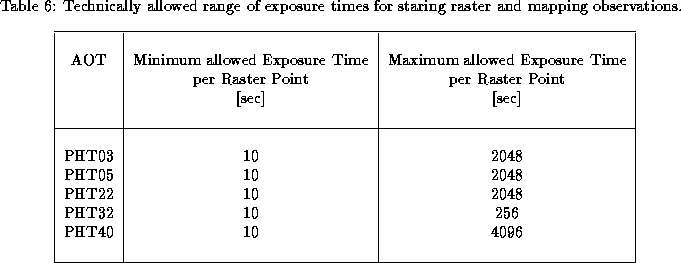



Next: Detector Drifts
Up: Limits for Exposure
Previous: Single Pointing Observations

For the staring raster and mapping modes the exposure times need not be a
power of two in seconds as is the case for single pointing observations.
The measurements are performed in a way that for one
filter setting a continuous exposure is
started at the first spacecraft raster position. This exposure lasts
for the performance of the complete raster or mapping observation including
all intervening microslews. Since a microslew cannot be
guaranteed to last for an integer multiple of 2 seconds (see ISO Observer's
Manual for calculation of microslew duration) the constraint of having powers
of two in seconds for the exposure time was not pertained for raster
staring and mapping observations.
This means that individual integration ramps can start or end
when the spacecraft is slewing. For data reduction the data taken
when the spacecraft is dwelling on a raster
position can be distinguished from those taken during the microslews by
checking the status of the so-called On-Target Flag which will be always set,
if the satellite has achieved a stable pointing on a raster position (within
an error cone of a few arcseconds).
For staring raster and mapping
observations there are lower and upper limits for exposure time values per
raster position. The lower limit is given by a minimum spacecraft dwell
time per
raster position which is 10 seconds. The upper limits are represented as
powers of two in seconds. Note that
obeying the maximum exposure time limit given in Tab. 6
does not
guarantee the feasibility of a mapping observation as this also depends
on the total number of selected raster positions and hence the total
performance time of the map. One contiguous map should not last for longer
than 20000 seconds (5.5 hours). A special calculation for the exposure time
per raster position is needed for the PHT-C array observing mode, which
performs oversampled
mapping, where a certain sky position will be viewed several times from
different raster positions, and the measurement per raster position comprises
12 (for C100) or 6 (for C200) chopper positions on adjacent sky pointings.
A detailed description
how to assess the exposure times in this mode is given in the cookbook
(Section 6.6). Table 6 gives a
summary of the minimum and
maximum exposure times per raster point for staring raster and mapping
observing modes.




Next: Detector Drifts
Up: Limits for Exposure
Previous: Single Pointing Observations
Tue Dec 6 17:24:45 MET 1994








